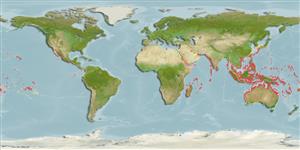Common names from other countries
Classification / Names / Names
ชื่อสามัญ | ชื่อพ้อง | Catalog of Fishes (gen., sp.) | ITIS | CoL | WoRMS
Environment: milieu / climate zone / depth range / distribution range
นิเวศวิทยา
; ระดับความลึก 0 - 81 m (Ref. 104607), usually 0 - 20 m (Ref. 75831). Tropical
Indo-Pacific: from East Africa, to eastern Polynesia; north to southern Japan and south to Queensland.
Length at first maturity / ขนาด / น้ำหนัก / Age
Maturity: Lm ? range ? - ? cm Max length : 4.0 cm SHH เพศผู้/กระเทย; (Ref. 348); common length : 3.0 cm SHH เพศผู้/กระเทย; (Ref. 348)
Commonly collected in many areas, mainly for decorative purposes. Found in intertidal (Ref. 75831), littoral and sublittoral areas with open coral reef and sandy mixed, and seagrass bottoms (Ref. 104607).
Life cycle and mating behavior
วัยเจริญพันธุ์ | การสืบพันธุ์ | การวางไข่ | เซลสืบพันธ์ของเพศเมีย(ไข่) | ความดกของไข่ | ตัวอ่อน
Members of the class Bivalvia are mostly gonochoric, some are protandric hermaphrodites. Life cycle: Embryos develop into free-swimming trocophore larvae, succeeded by the bivalve veliger, resembling a miniature clam.
Poutiers, J.M. 1998. (Ref. 348)
IUCN Red List Status (Ref. 130435)
CITES status (Ref. 108899)
Not Evaluated
Not Evaluated
Threat to humans
Harmless
Human uses
| FishSource |
เครื่องมือ
ข้อมูลเพิ่มเติม
Age/Size
การเจริญเติบโต
Length-weight
Length-length
สัณฐานวิทยา
ตัวอ่อน
อุดมสมบรูณ์
แหล่งที่มาจากอินเตอร์เน็ต
Estimates based on models
Preferred temperature
(Ref.
115969): 24.4 - 29, mean 28 (based on 1118 cells).
Vulnerability
Low vulnerability (10 of 100).
